一、为什么要使用ArrayMap
ArrayMap是一个普通的键值映射的数据结构,这种数据结构比传统的HashMap有着更好的内存管理效率。传统HashMap非常的好用,但是它对内存的占用非常的大。为了解决HashMap更占内存的弊端,Android提供了内存效率更高的ArrayMap。
二、ArrayMap的实现原理
它内部使用两个数组进行工作,其中一个数组记录key hash过后的顺序列表,另外一个数组按key的顺序记录Key-Value值,如下图所示:
这样做的好处就是它避免了为每个加入到map的实体构造额外的对象。在ArrayMap大小增长的时候,我们也只需要复制两个数组的实体,而不需要重新构建一个hash map。
我们需要注意的是这种数据结构不适合包含大量数据项的数据结构,因为它内部使用的是数组,对数组进行插入和删除操作效率比较低。
三、源码分析
正如上面所说,它里面包含了两个数组,看看下面定义,另外定义一个size来记录存放的实体个数:
int[] mHashes;
Object[] mArray;
int mSize;1、构造函数
public ArrayMap() {
mHashes = ContainerHelpers.EMPTY_INTS;
mArray = ContainerHelpers.EMPTY_OBJECTS;
mSize = 0;
}可以看到,这里就是对这两个数组以及这个size进行初始化,它定义了两个空数组,并且把大小置为0。
具体可以看看ContainerHelpers里面的实现:
static final int[] EMPTY_INTS = new int[0];
static final Object[] EMPTY_OBJECTS = new Object[0];从上面可以看到,它并没有为数组分配空间,在要使用的时候才会分配空间,这也是ArrayMap比HashMap内存占用率低的一个原因。
第二个构造函数
public ArrayMap(int capacity) {
if (capacity == 0) {
mHashes = ContainerHelpers.EMPTY_INTS;
mArray = ContainerHelpers.EMPTY_OBJECTS;
} else {
allocArrays(capacity);
}
mSize = 0;
}这里为数组的初始化设置了一个大小,如果capacity为0,那么就跟上面第一个构造函数一样,如果不为0,那么需要为数组分配大小,具体看看allocArrays函数。
private void allocArrays(final int size) {
if (mHashes == EMPTY_IMMUTABLE_INTS) {
throw new UnsupportedOperationException("ArrayMap is immutable");
}
if (size == (BASE_SIZE*2)) {
synchronized (ArrayMap.class) {
if (mTwiceBaseCache != null) {
final Object[] array = mTwiceBaseCache;
mArray = array;
mTwiceBaseCache = (Object[])array[0];
mHashes = (int[])array[1];
array[0] = array[1] = null;
mTwiceBaseCacheSize--;
if (DEBUG) Log.d(TAG, "Retrieving 2x cache " + mHashes
+ " now have " + mTwiceBaseCacheSize + " entries");
return;
}
}
} else if (size == BASE_SIZE) {
synchronized (ArrayMap.class) {
if (mBaseCache != null) {
final Object[] array = mBaseCache;
mArray = array;
mBaseCache = (Object[])array[0];
mHashes = (int[])array[1];
array[0] = array[1] = null;
mBaseCacheSize--;
if (DEBUG) Log.d(TAG, "Retrieving 1x cache " + mHashes
+ " now have " + mBaseCacheSize + " entries");
return;
}
}
}
mHashes = new int[size];
mArray = new Object[size<<1];
}对于BASE_SIZE*2和BASE_SIZE两种尺寸的数组在这里它并没有对它们进行释放,而是把它们缓存起来,这样我们在分配的时候,如果需要分配这两种大小的数组,就可以直接从缓存中取得,否则,就直接new两个数组,第二个数组存放的是键值对,所以大小是size的两倍,size<<1左移一位操作就相当于乘以2,从上图就可以看到效果。
下面我们来说说缓存和使用缓存的过程,我们先来看看释放数组的操作代码。
private static void freeArrays(final int[] hashes, final Object[] array, final int size) {
if (hashes.length == (BASE_SIZE*2)) {
synchronized (ArrayMap.class) {
if (mTwiceBaseCacheSize < CACHE_SIZE) {
array[0] = mTwiceBaseCache;
array[1] = hashes;
for (int i=(size<<1)-1; i>=2; i--) {
array[i] = null;
}
mTwiceBaseCache = array;
mTwiceBaseCacheSize++;
if (DEBUG) Log.d(TAG, "Storing 2x cache " + array
+ " now have " + mTwiceBaseCacheSize + " entries");
}
}
} else if (hashes.length == BASE_SIZE) {
synchronized (ArrayMap.class) {
if (mBaseCacheSize < CACHE_SIZE) {
array[0] = mBaseCache;
array[1] = hashes;
for (int i=(size<<1)-1; i>=2; i--) {
array[i] = null;
}
mBaseCache = array;
mBaseCacheSize++;
if (DEBUG) Log.d(TAG, "Storing 1x cache " + array
+ " now have " + mBaseCacheSize + " entries");
}
}
}
}mBaseCache和mTwiceBaseCache两种size的缓存过程相同,我们以mTwiceBaseCache为例来分析它的过程。
为了防止过多的缓存数组,所以代码中对其设置了一个上限CACHE_SIZE,值为10,如果缓存的数目达到了这个值,就不能进行缓存了。所以首先判断mTwiceBaseCacheSize的大小。
假设还没有达到上限CACHE_SIZE,执行核心代码:
array[0] = mTwiceBaseCache;
array[1] = hashes;
for (int i=(size<<1)-1; i>=2; i--) {
array[i] = null;
}
mTwiceBaseCache = array;
mTwiceBaseCacheSize++;第一次执行freeArrays得到如下图:
第二次执行freeArrays得到如下图:
将上面的核心代码和图形结合,就可以知道它的执行过程了。
在allocArrays中,使用缓存的核心代码如下:
final Object[] array = mTwiceBaseCache;
mArray = array;
mTwiceBaseCache = (Object[])array[0];
mHashes = (int[])array[1];
array[0] = array[1] = null;
mTwiceBaseCacheSize--;由于mTwiceBaseCache指向整个Object数组,这个数组就是存储键值对的数组,可以直接拿了使用,用来存放键值对,因为这个数组的第一个元素存放的上一个键值对数组的引用,把它存放在mTwiceBaseCache中,这样下一次就可以获取下一个缓存的数组了,第二个元素存放的是hash数组的引用,这样就可以得到这个hash数组,直接来使用。
下面来看看另外一个构造函数,下面这个构造函数是创建一个不可变的hansh数组。
private ArrayMap(boolean immutable) {
mHashes = EMPTY_IMMUTABLE_INTS;
mArray = ContainerHelpers.EMPTY_OBJECTS;
mSize = 0;
}可以看到唯一不同的就是它的mHashes的赋值。
static final int[] EMPTY_IMMUTABLE_INTS = new int[0];可以看到EMPTY_IMMUTABLE_INTS是一个静态的变量,就是说所有的hash值会共用一个数组。
下面是最后一个构造函数,它就是用一个ArrayMap来初始化另外一个ArrayMap。
public ArrayMap(ArrayMap map) {
this();
if (map != null) {
putAll(map);
}
}从实现函数可以看到,它就是调用了一个putAll函数。
public void putAll(ArrayMap<? extends K, ? extends V> array) {
final int N = array.mSize;
ensureCapacity(mSize + N);
if (mSize == 0) {
if (N > 0) {
System.arraycopy(array.mHashes, 0, mHashes, 0, N);
System.arraycopy(array.mArray, 0, mArray, 0, N<<1);
mSize = N;
}
} else {
for (int i=0; i<N; i++) {
put(array.keyAt(i), array.valueAt(i));
}
}
}可以看到它首先执行了ensureCapacity,它的作用就是分配空间,下面来看看实现吧。
public void ensureCapacity(int minimumCapacity) {
if (mHashes.length < minimumCapacity) {
final int[] ohashes = mHashes;
final Object[] oarray = mArray;
allocArrays(minimumCapacity);
if (mSize > 0) {
System.arraycopy(ohashes, 0, mHashes, 0, mSize);
System.arraycopy(oarray, 0, mArray, 0, mSize<<1);
}
freeArrays(ohashes, oarray, mSize);
}
}上面代码应该很容易看懂,它就是根据当前数组的长度来看是否需要重新分配空间。
分配完了空间回到上面的函数,如果mSize为0,就是说当前没有存储任何元素,这样就执行System.arraycopy分别进行数组的复制,否则,就通过循环,使用put函数一个一个键值对进行添加。
顺着思路,我们继续分析,下面我们趁热打铁,看看put函数吧,这个函数我们可能会经常的使用到,就是向集合中添加元素。
@Override
public V put(K key, V value) {
final int hash;
int index;
if (key == null) {
hash = 0;
index = indexOfNull();
} else {
hash = key.hashCode();
index = indexOf(key, hash);
}
if (index >= 0) {
index = (index<<1) + 1;
final V old = (V)mArray[index];
mArray[index] = value;
return old;
}
index = ~index;
if (mSize >= mHashes.length) {
final int n = mSize >= (BASE_SIZE*2) ? (mSize+(mSize>>1))
: (mSize >= BASE_SIZE ? (BASE_SIZE*2) : BASE_SIZE);
if (DEBUG) Log.d(TAG, "put: grow from " + mHashes.length + " to " + n);
final int[] ohashes = mHashes;
final Object[] oarray = mArray;
allocArrays(n);
if (mHashes.length > 0) {
if (DEBUG) Log.d(TAG, "put: copy 0-" + mSize + " to 0");
System.arraycopy(ohashes, 0, mHashes, 0, ohashes.length);
System.arraycopy(oarray, 0, mArray, 0, oarray.length);
}
freeArrays(ohashes, oarray, mSize);
}
if (index < mSize) {
if (DEBUG) Log.d(TAG, "put: move " + index + "-" + (mSize-index)
+ " to " + (index+1));
System.arraycopy(mHashes, index, mHashes, index + 1, mSize - index);
System.arraycopy(mArray, index << 1, mArray, (index + 1) << 1, (mSize - index) << 1);
}
mHashes[index] = hash;
mArray[index<<1] = key;
mArray[(index<<1)+1] = value;
mSize++;
return null;
}从上面,可以看到如果键值key为null,hash会被赋值为0,并且执行indexOfNull函数,就是查找null对应的索引index的值。
int indexOfNull() {
//得到元素的个数
final int N = mSize;
// 如果没有任何元素,即执行返回,根本不需要查询
if (N == 0) {
return ~0;
}
//通过二分查找来找到mHashes中hash为0的索引值
int index = ContainerHelpers.binarySearch(mHashes, N, 0);
// 如果没有找到,说明没有对应的实体,index < 0
if (index < 0) {
return index;
}
// 如果找到了对应的index,则在mArray中索引其对应的值,所以这个值为null,则返回index
//index<<1就相当于index*2,因为mArray数组里面存放的是键值对
if (null == mArray[index<<1]) {
return index;
}
// 如果上面仍不满足条件,遍历index索引后面的所有hash值
int end;
for (end = index + 1; end < N && mHashes[end] == 0; end++) {
if (null == mArray[end << 1]) return end;
}
// 如果上面仍不满足条件,遍历index索引前面的所有hash值
for (int i = index - 1; i >= 0 && mHashes[i] == 0; i--) {
if (null == mArray[i << 1]) return i;
}
//如果key没有找到,就返回这个值的负值,表示需要添加一个新的实体
return ~end;
}回到上面的函数,如果key不为空,就执行indexOf来找到它对应的索引值。
int indexOf(Object key, int hash) {
final int N = mSize;
// Important fast case: if nothing is in here, nothing to look for.
if (N == 0) {
return ~0;
}
int index = ContainerHelpers.binarySearch(mHashes, N, hash);
// If the hash code wasn't found, then we have no entry for this key.
if (index < 0) {
return index;
}
// If the key at the returned index matches, that's what we want.
if (key.equals(mArray[index<<1])) {
return index;
}
// Search for a matching key after the index.
int end;
for (end = index + 1; end < N && mHashes[end] == hash; end++) {
if (key.equals(mArray[end << 1])) return end;
}
// Search for a matching key before the index.
for (int i = index - 1; i >= 0 && mHashes[i] == hash; i--) {
if (key.equals(mArray[i << 1])) return i;
}
// Key not found -- return negative value indicating where a
// new entry for this key should go. We use the end of the
// hash chain to reduce the number of array entries that will
// need to be copied when inserting.
return ~end;
}它的过程跟上面基本一样,这里就不分析了,它的过程如下图所示:
直接回到上面的调用函数:
如果返回的index>0,则说明数组里面已经存在相同的key值,所以我们直接更新它的value值就可以了。
如果返回的index<0,则说明没有找到这个key对应的索引值,所以就需要新插入一个元素。
我们把上面的核心代码放下面具体来分析分析。
//得到上面的end值
index = ~index;
//判断是否需要增加数组的容量
if (mSize >= mHashes.length) {
//增加数组容量是按BASE_SIZE*2或者BASE_SIZE来分配新容量
final int n = mSize >= (BASE_SIZE*2) ? (mSize+(mSize>>1))
: (mSize >= BASE_SIZE ? (BASE_SIZE*2) : BASE_SIZE);
if (DEBUG) Log.d(TAG, "put: grow from " + mHashes.length + " to " + n);
//当当前的两个数组的引用缓存起来
final int[] ohashes = mHashes;
final Object[] oarray = mArray;
//分配新的空间大小,就是按照上面的容量n重新分配两个新的数组
allocArrays(n);
//把之前两个数组中的值重新赋值给新的数组
if (mHashes.length > 0) {
if (DEBUG) Log.d(TAG, "put: copy 0-" + mSize + " to 0");
System.arraycopy(ohashes, 0, mHashes, 0, ohashes.length);
System.arraycopy(oarray, 0, mArray, 0, oarray.length);
}
//把之前的两个数组是释放掉
freeArrays(ohashes, oarray, mSize);
}
//从index开始,统一往后挪动一个位置,把新数组中的index位置的空间挪出来,用来存放我们要插入的值
if (index < mSize) {
if (DEBUG) Log.d(TAG, "put: move " + index + "-" + (mSize-index)
+ " to " + (index+1));
System.arraycopy(mHashes, index, mHashes, index + 1, mSize - index);
System.arraycopy(mArray, index << 1, mArray, (index + 1) << 1, (mSize - index) << 1);
}
//把我们需要插入的值放入指定的index位置,mSize++
mHashes[index] = hash;
mArray[index<<1] = key;
mArray[(index<<1)+1] = value;
mSize++;可以看到正如上面所说,执行插入操作的效率比较低,它需要统一的挪动数组,效果图如下所示:
下面我们来看看删除操作:
public V removeAt(int index) {
//得到指定索引的value值
final Object old = mArray[(index << 1) + 1];
//如果mSize<=0,说明数组没有元素,即对数组清空,重新初始化
if (mSize <= 1) {
// Now empty.
if (DEBUG) Log.d(TAG, "remove: shrink from " + mHashes.length + " to 0");
freeArrays(mHashes, mArray, mSize);
mHashes = ContainerHelpers.EMPTY_INTS;
mArray = ContainerHelpers.EMPTY_OBJECTS;
mSize = 0;
} else {
//如果分配的空间大于BASE_SIZE*2,并且里面已经被使用的空间小于mHashes.length/3
if (mHashes.length > (BASE_SIZE*2) && mSize < mHashes.length/3) {
// Shrunk enough to reduce size of arrays. We don't allow it to
// shrink smaller than (BASE_SIZE*2) to avoid flapping between
// that and BASE_SIZE.
//压缩数组的大小,避免占用不必要的空间
final int n = mSize > (BASE_SIZE*2) ? (mSize + (mSize>>1)) : (BASE_SIZE*2);
if (DEBUG) Log.d(TAG, "remove: shrink from " + mHashes.length + " to " + n);
final int[] ohashes = mHashes;
final Object[] oarray = mArray;
//重新分配数组
allocArrays(n);
mSize--;
//把旧数组中除了要删除的元素外,把其他的复制到新的数组中
if (index > 0) {
if (DEBUG) Log.d(TAG, "remove: copy from 0-" + index + " to 0");
System.arraycopy(ohashes, 0, mHashes, 0, index);
System.arraycopy(oarray, 0, mArray, 0, index << 1);
}
if (index < mSize) {
if (DEBUG) Log.d(TAG, "remove: copy from " + (index+1) + "-" + mSize
+ " to " + index);
System.arraycopy(ohashes, index + 1, mHashes, index, mSize - index);
System.arraycopy(oarray, (index + 1) << 1, mArray, index << 1,
(mSize - index) << 1);
}
} else {
//如果不需要重新分配数组的大小时
//直接将数组index后面的元素统一前移一个元素
mSize--;
if (index < mSize) {
if (DEBUG) Log.d(TAG, "remove: move " + (index+1) + "-" + mSize
+ " to " + index);
System.arraycopy(mHashes, index + 1, mHashes, index, mSize - index);
System.arraycopy(mArray, (index + 1) << 1, mArray, index << 1,
(mSize - index) << 1);
}
//这样最后一个元素就会空处理,将它置为null
mArray[mSize << 1] = null;
mArray[(mSize << 1) + 1] = null;
}
}
return (V)old;
}过程可以看上面的注释,可以看到它分两种情况:
1、当空间利用率太低的时候,它就会重新分配较小的空间,它之前的内容复制过来,然后把之前的数组释放掉,这样保证内存的占有率较低。
2、当空间利用率满足条件的时候,就直接在原有的数组里面完成删除操作,也就是把数组元素统一前移。
另外,我们可以看到删除操作也要进行数组的统一移动,所以效率比较低,这也是为什么ArrayMap不适合存放大数据量的数据。
效果如下图所示:
了解了上面过程,我们应该在满足下面2个条件的时候才考虑使用ArrayMap:
1、对象个数的数量级最好是千以内;
2、数据组织形式包含Map结构。









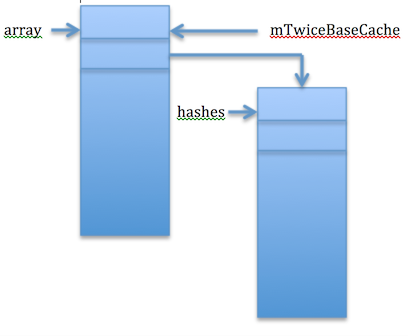
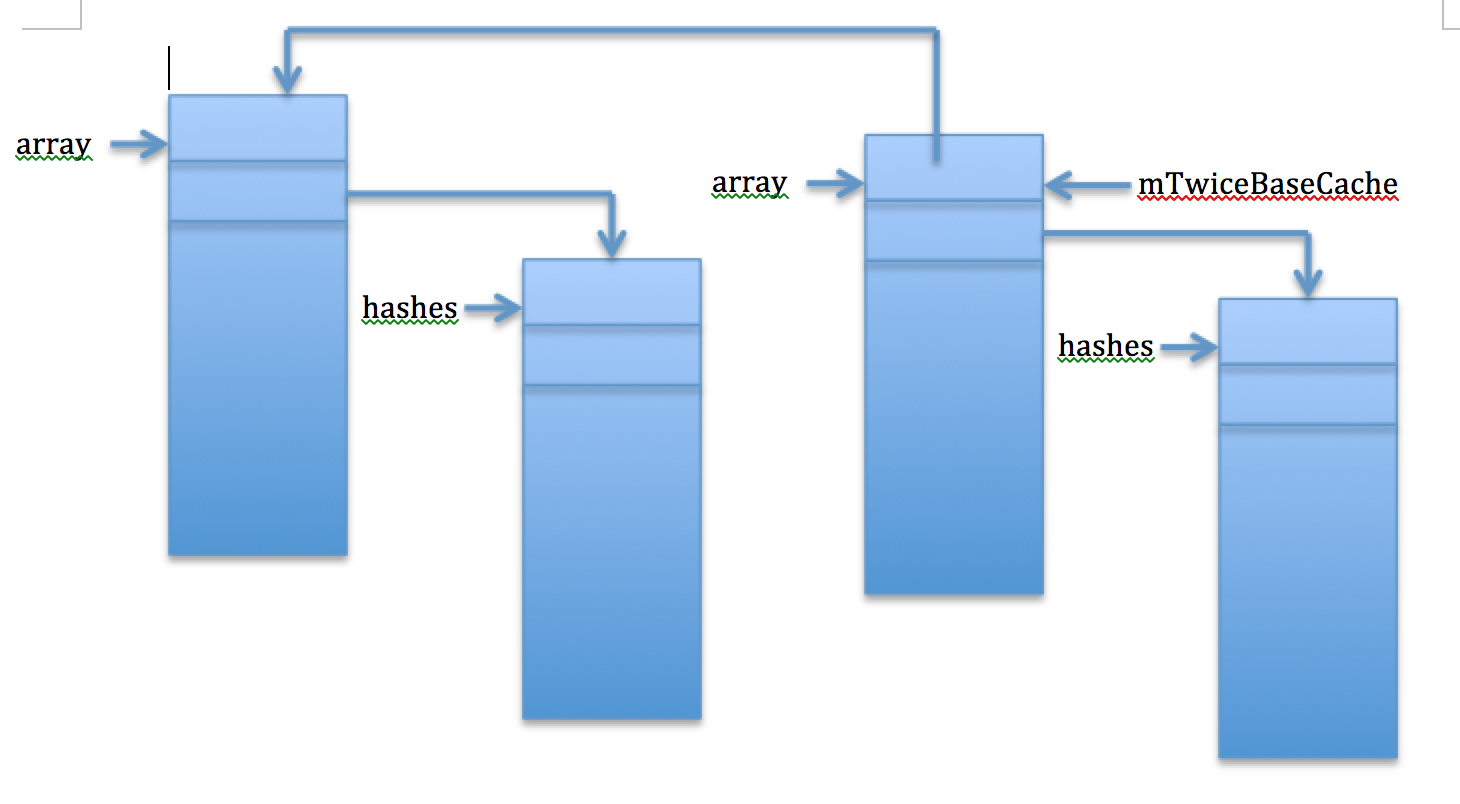
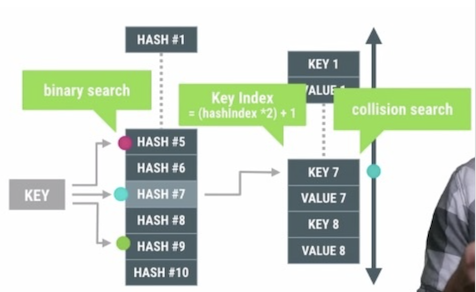
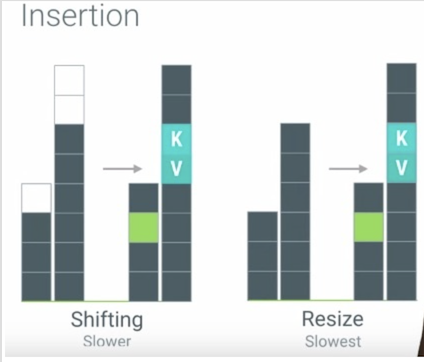
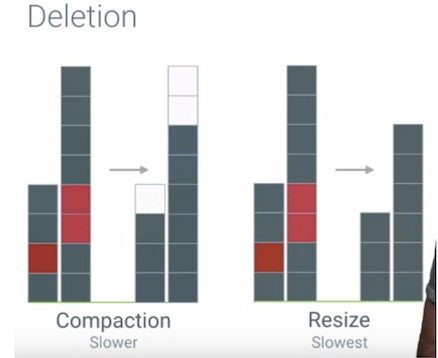













 1850
1850











 被折叠的 条评论
为什么被折叠?
被折叠的 条评论
为什么被折叠?








